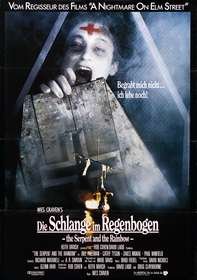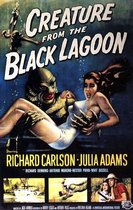Our editor-in-chief Nate Yapp is proud to have contributed to the new book Hidden Horror: A Celebration of 101 Underrated and Overlooked Fright Flicks, edited by Aaron Christensen. Another contributors include Anthony Timpone, B.J. Colangelo, Dave Alexander, Classic-Horror.com's own Robert C. Ring and John W. Bowen. Pick up a copy today from Amazon.com!
The Serpent and the Rainbow (1988)
A creepy travelogue of exaggerated dark sides of other cultures, Wes Craven 's The Serpent and the Rainbow is a fine horror film with the scope of Indiana Jones and the attitude of Freddy Krueger.
"Inspired by a true story" (more on that in a minute), The Serpent and the Rainbow tells the tale of Dennis Allen, an ethnobotanist/anthropologist (the real guy, Wade Davis, was actually a grad student at the time) from Harvard. As you'd suspect, Allen likes to travel to exotic locales and search for little known flora-his main interest seems to be plants that have medicinal value.
After an excellent, darkly atmospheric intro to Haiti voodoo culture in 1979, we're transported to the Amazon basin in 1985, where Allen is plant hunting. He's given a psychotropic liquid by an Amazon shaman-a natural enough occurrence, and from that point on, Craven has a logical, wide avenue for invoking the surrealism both he and his fans love. For a moment, The Serpent and the Rainbow toys with becoming Craven's version of Cannibal Holocaust, but Allen quickly escapes the beautifully photographed jungle (I believe this bit was actually shot in the Dominican Republic) and heads back to Boston (and speaking of sumptuous cinematography, lenser John Lindley captures one of the best juxtapositions of Trinity Church against the John Hancock Tower that I've seen).
Word of Allen's South American exploits makes its way around town, and soon a honcho from a major Boston pharmaceutical company is asking Allen to head to Haiti to see what he can learn about zombification. The goal is to acquire an alternate, less dangerous (yeah, but who ever thought zombies weren't dangerous-hasn't the suit ever heard of Romero or Fulci?) method of anesthesia.
So, the bulk of The Serpent and the Rainbow takes place in Duvalier-ridden Haiti (which fuels some unnecessary political critique-part of the reason I docked this flick a half point), as Allen hooks up with a pulchritudinous doctor and searches the seedy, evil underbelly of voodoo culture for the key to zombification.
As we all know, films tend to come in waves, for whatever reason. The cynical say its because a surprise hit occurred and filmmakers quickly try to cash in the wake of the precursor. Even more cynical folks might say its because everyone steals ideas as scripts make the rounds of Hollywood agents, producers and directors. Anyone with an affinity for more esoteric explanations might say that there's just "something in the air" that creates the coincidences, whether we appeal to the Eastern concept of artistic ideas being akin to some non-physical current that we tap into or we take the more down-to-earth approach of it being caused by similar artistic reactions to similar socio-cultural states.
The Serpent and the Rainbow bears more than a passing stylistic similarity to Alan Parker's film Angel Heart (1987), although it is not quite as good as Parker's film. There are also similarities in tone, if not execution, to John Carpenter's Prince of Darkness (also 1987). For my money, The Serpent and the Rainbow blows Prince of Darkness out of the water. The Serpent and the Rainbow succeeds for many reasons. The script is tight, focused, and never breaks its internal logic, despite the invocation of a bit of silly science. This is especially remarkable given the span in time, locale and shifting perspectives on the main subject matter. Even more amazing, scripters Richard Maxwell and A. R. Simoun bring in at least two significant subplots that never get in the way of the main thrust and never slow the proceedings down-they only enhance the film.
Craven's direction is as good here as in any of his other films, including the best of the Elm Street movies. Every shot counts and every shot is expertly conceived. The cinematography and production design further intensify the moods, always creating the exact right atmosphere to match the setting and story-the voodoo stuff is ominous, the hospital and lab stuff is clinical, the beach house is romantic, etc. That the mood can vary so much makes the horror scenes work better due to the contrast.
The effects are always perfect. Like the other elements, they always flow with the film rather than stick out like a sore thumb. The same goes for the score, which contains wonderful "traditional" Haitian music as well as great orchestral compositions.
The only other slight flaw I can cite is that during one extended, non-horrific voodoo sequence, leading up to the big love scene, The Serpent and the Rainbow slows down for just a minute or two too long. Still, that in conjunction with the political commentary is a slight enough nick to only bring my opinion down a half-point.
In the wake of Wade Davis' books, there's been a lot of speculation regarding the degree of truth in The Serpent and the Rainbow. I come down on the side of strong skepticism (I agree Davis went to Haiti, asked some questions, saw a preparation ritual of zombie-powder and brought some back for analysis), so your view of the truth of the claims shouldn't affect your enjoyment of this excellent film. I loved it. And if you have even a smidgen of belief in the "supernatural" aspects of voodoo, you might just get scared out of your wits -- my wife believes and screamed three times; I think that's a new record.








